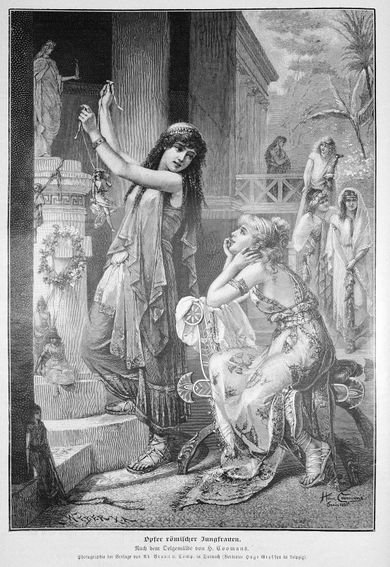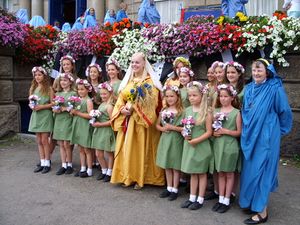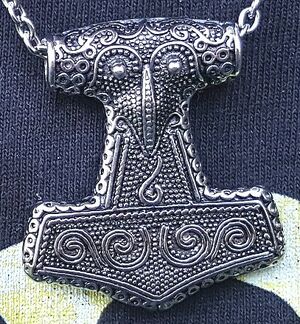وثنية
الوثنية (إنگليزية: Paganism؛ من اللاتينية الكلاسيكية pāgānus "الريفيون" أو "المحليون"، لاحقاً "المدنيون")، هو مصطلح استخدم لأول مرة في القرن الرابع من قبل المسيحيون الأوائل لوصف الأشخاص في الرومان الذين كانوا يعبدون الآلهة المتعددة[1] أو الديانات العرقية وليس اليهودية. في عصر الإمبراطورية الرومانية، كان الأفراد ضمن طبقة الوثنيين إما لأنهم كانوا ريفيين ومحليين بشكل متزايد بالنسبة إلى السكان المسيحيين، أو لأنهم لم يكونوا "ميليتس كريستي" (جنود المسيح).[2][3] كانت المصطلحات البديلة في النصوص المسيحية هي "الهلنيين" و"غير المؤمنين" و"الوثنيين".[1] Ritual sacrifice was an integral part of ancient Graeco-Roman religion[4] and was regarded as an indication of whether a person was pagan or Christian.[4] Paganism has broadly connoted the "religion of the peasantry".[1][5]
During and after the Middle Ages, the term paganism was applied to any non-Christian religion, and the term presumed a belief in false god(s).[6][7]
The origin of the application of the term pagan to polytheism is debated.[8] In the 19th century, paganism was adopted as a self-descriptor by members of various artistic groups inspired by the ancient world. In the 20th century, it came to be applied as a self-descriptor by practitioners of Modern Paganism, Neopagan movements and Polytheistic reconstructionists. Modern pagan traditions often incorporate beliefs or practices, such as nature worship, that are different from those in the largest world religions.[9][10]
Contemporary knowledge of old pagan religions and beliefs comes from several sources, including anthropological field research records, the evidence of archaeological artifacts, and the historical accounts of ancient writers regarding cultures known to Classical antiquity.
Most modern pagan religions existing today (Modern or Neopaganism[11][12]) express a world view that is pantheistic, panentheistic, polytheistic or animistic, but some are monotheistic.[13]
. . . . . . . . . . . . . . . . . . . . . . . . . . . . . . . . . . . . . . . . . . . . . . . . . . . . . . . . . . . . . . . . . . . . . . . . . . . . . . . . . . . . . . . . . . . . . . . . . . . . . . . . . . . . . . . . . . . . . . . . . . . . . . . . . . . . . . . . . . . . . . . . . . . . . . . . . . . . . . . . . . . . . . . .
المصطلحات وأصل الاسم
Hellene
Heathen
التعريف
Defining paganism is complex and problematic. Understanding the context of its associated terminology is important.[14] Early Christians referred to the diverse array of cults around them as a single group for reasons of convenience and rhetoric.[15] While paganism generally implies polytheism, the primary distinction between classical pagans and Christians was not one of monotheism versus polytheism, as not all pagans were strictly polytheist. Throughout history, many of them believed in a supreme deity. However, most such pagans believed in a class of subordinate gods/daimons—see henotheism—or divine emanations.[13] To Christians, the most important distinction was whether or not someone worshipped the one true God. Those who did not (polytheist, monotheist, or atheist) were outsiders to the Church and thus considered pagan.[16] Similarly, classical pagans would have found it peculiar to distinguish groups by the number of deities followers venerate. They would have considered the priestly colleges (such as the College of Pontiffs or Epulones) and cult practices more meaningful distinctions.[17]
الإدراك
التعصب العرقي
التاريخ
قبل التاريخ
العصر البرونزي-أوائل العصر الحديدي
العتيق الكلاسيكي
Late Antiquity and Christianization
ظهور الإسلام
Arabic paganism gradually disappeared during prophet Muhammad's era through Islamization.[18][19] The sacred months of the Arab pagans were the 1st, 7th, 11th and 12th months of the Islamic calendar.[20] After Muhammad had conquered Mecca he set out to convert the pagans.[21][22][23] One of the last military campaigns that Muhammad ordered against the Arab pagans was the Demolition of Dhul Khalasa. It occurred in April and May 632 AD, in 10AH of the Islamic Calendar. Dhul Khalasa is referred to as both an idol and a temple, and it was known by some as the Ka'ba of Yemen, built and worshipped by pagan tribes.[24][25][26][27][28][29][30][31][32]
. . . . . . . . . . . . . . . . . . . . . . . . . . . . . . . . . . . . . . . . . . . . . . . . . . . . . . . . . . . . . . . . . . . . . . . . . . . . . . . . . . . . . . . . . . . . . . . . . . . . . . . . . . . . . . . . . . . . . . . . . . . . . . . . . . . . . . . . . . . . . . . . . . . . . . . . . . . . . . . . . . . . . . . .
أوائل العصر الحديث
Romanticism
الوثنية الحديثة
 مقالة مفصلة: الوثنية الحديثة
مقالة مفصلة: الوثنية الحديثة
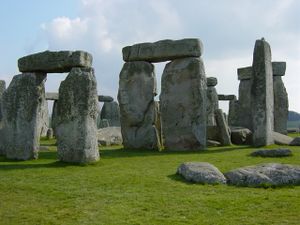
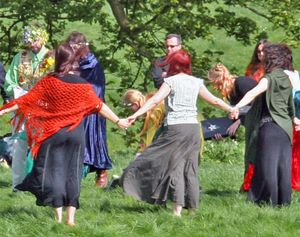
Ethnic religions of pre-Christian Europe
- Albanian mythology
- Baltic mythology
- Basque mythology
- Celtic polytheism
- Etruscan mythology
- Finnic mythologies
- Germanic paganism
- Ancient Greek religion
- Hungarian Native Faith
- Minoan religion
- Mari Native Religion
- Mordvin Native Religion
- Norse mythology
- Religion in ancient Rome
- Sámi shamanism
- Scythian religion
- Slavic paganism
انظر أيضاً
- Animism
- Astrotheology
- Crypto-paganism
- Dharmic religions
- East Asian religions
- Eleusinian Mysteries
- Henotheism
- Jungian psychology
- Kemetism
- List of Pagans
- Neopagan temples in Europe
- List of Neopagan movements
- List of religions and spiritual traditions
- Myth and ritual
- Naturalistic pantheism
- Nature worship
- Panentheism
- Polytheism
- Sentientism
- Totemism
الهوامش
- ^ أ ب ت Peter Brown (1999). "Pagan". In Glen Warren Bowersock; Peter Brown; Oleg Grabar (eds.). Late Antiquity: A Guide to the Postclassical World. Harvard University Press. pp. 625–26. ISBN 978-0-674-51173-6.
- ^ J. J. O'Donnell (1977), Paganus: Evolution and Use, Classical Folia, 31: 163–69.
- ^ Augustine, Divers. Quaest. 83.
- ^ أ ب Jones, Christopher P. (2014). Between Pagan and Christian. Cambridge, Massachusetts: Harvard University Press. ISBN 978-0-674-72520-1.
- ^ Owen Davies (2011). Paganism: A Very Short Introduction. Oxford University Press. pp. 1–2. ISBN 978-0-19-162001-0.
- ^ Kaarina Aitamurto (2016). Paganism, Traditionalism, Nationalism: Narratives of Russian Rodnoverie. Routledge. pp. 12–15. ISBN 978-1-317-08443-3.
- ^ Owen Davies (2011). Paganism: A Very Short Introduction. Oxford University Press. pp. 1–6, 70–83. ISBN 978-0-19-162001-0.
- ^ Davies, Owen (2011). Paganism: A Very Short Introduction. New York: Oxford University Press. ISBN 978-0191620010.
- ^ Paganism, Oxford Dictionary (2014)
- ^ Paganism, The Encyclopedia of Religion and Nature, Bron Taylor (2010), Oxford University Press, ISBN 978-0199754670
- ^ Lewis, James R. (2004). The Oxford Handbook of New Religious Movements. Oxford University Press. p. 13. ISBN 0-19-514986-6.
- ^ Hanegraff, Wouter J. (1006). New Age Religion and Western Culture: Esotericism in the Mirror of Secular Thought. Brill Academic Publishers. p. 84. ISBN 90-04-10696-0.
- ^ أ ب Cameron 2011, pp. 28, 30.
- ^ Davies 2011, Defining paganism.
- ^ Cameron 2011, p. 26.
- ^ Cameron 2011, pp. 27, 31.
- ^ Cameron 2011, p. 29.
- ^ Mubarakpuri, Saifur Rahman Al (2005), The sealed nectar: biography of the Noble Prophet, Darussalam Publications, pp. 245–46, ISBN 978-9960-899-55-8, https://books.google.com/books?id=r_80rJHIaOMC&pg=PA245
- ^ Muhammad Saed Abdul-Rahman, Tafsir Ibn Kathir Juz' 2 (Part 2): Al-Baqarah 142 to Al-Baqarah 252 2nd Edition, p. 139, MSA Publication Limited, 2009, ISBN 1861796765. (online)
- ^ Mubarakpuri, The Sealed Nectar (Free Version), p. 129
- ^ Sa'd, Ibn (1967). Kitab al-tabaqat al-kabir, By Ibn Sa'd, Volume 2. Pakistan Historical Society. p. 380. ASIN B0007JAWMK.
- ^ Rahman al-Mubarakpuri, Saifur (2005), The Sealed Nectar, Darussalam Publications, p. 269, ISBN 9798694145923, https://books.google.com/books?id=-ppPqzawIrIC&pg=PA269
- ^ Mufti, M. Mukarram Ahmed (2007), Encyclopaedia of Islam, Anmol Publications Pvt Ltd, p. 103, ISBN 978-81-261-2339-1, https://books.google.com/books?id=oiAtbfbHgVoC&pg=PA103
- ^ Robertson Smith, William (2010). Kinship and Marriage in Early Arabia. Forgotten Books. p. 297. ISBN 978-1-4400-8379-2.
- ^ S. Salibi, Kamal (2007). Who Was Jesus?: Conspiracy in Jerusalem. Tauris Parke Paperbacks. p. 146. ISBN 978-1-8451-1314-8.
- ^ Muir, William (1878). The life of Mahomet. Kessinger Publishing. p. 219.
- ^ Mubarakpuri, Saifur Rahman Al (2002). When the Moon Split. DarusSalam. p. 296. ISBN 978-9960-897-28-8.
- ^ Glasse, Cyril (2003). The new encyclopedia of Islam. US: AltaMira Press. p. 251. ISBN 978-0-7591-0190-6.
- ^ صحيح البخاري، 5:59:641
- ^ Dermenghem, Émile (1930). The life of Mahomet. G. Routledge. p. 239. ISBN 978-9960-897-71-4.
Five hundred horsemen went to Dhul Khalasa to demolish the Yemenite Ka'ba
- ^ Ibn al Kalbi, Hisham (1952). The book of idols: being a translation from the Arabic of the Kitāb al-asnām. Princeton University Press. pp. 31–32. ASIN B002G9N1NQ.
- ^ The Book of Idols, Scribd, https://www.scribd.com/doc/34864705/The-Book-of-Idols, retrieved on 9 September 2017.
المصادر
- Cameron, Alan G. (2011). The Last Pagans of Rome. New York: Oxford University Press. ISBN 978-0199780914. OCLC 553365192.
- Davies, Owen (2011). Paganism: A Very Short Introduction. New York: Oxford University Press. ISBN 978-0191620010.
- Hua, Yih-Fen. book review to: Maria Effinger / Cornelia Logemann / Ulrich Pfisterer (eds): Götterbilder und Götzendiener in der Frühen Neuzeit. Europas Blick auf fremde Religionen. In: sehepunkte 13 (2013), Nr. 5 [15.05.2013], URL: http://www.sehepunkte.de/2013/05/21410.html. (Book review in English).
- Robert, P. & Scott, N. (1995). A History of Pagan Europe. New York, Barnes & Noble Books, ISBN 0-7607-1210-7.
- York, Michael (2003). Pagan Theology: Paganism as a World Religion NYU Press, ISBN 0-8147-9708-3.
. . . . . . . . . . . . . . . . . . . . . . . . . . . . . . . . . . . . . . . . . . . . . . . . . . . . . . . . . . . . . . . . . . . . . . . . . . . . . . . . . . . . . . . . . . . . . . . . . . . . . . . . . . . . . . . . . . . . . . . . . . . . . . . . . . . . . . . . . . . . . . . . . . . . . . . . . . . . . . . . . . . . . . . .
وصلات خارجية
 The Wiktionary definition of heathen
The Wiktionary definition of heathen Quotations related to وثنية at Wikiquote
Quotations related to وثنية at Wikiquote
